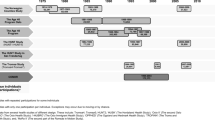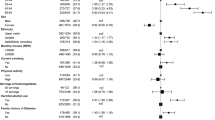Abstract
Both the noncommunicable diseases (NCDs) burden and the population of older adults are increasing in Nepal. This study aims to estimate the prevalence of behavioral and biological risk factors of common NCDs among Nepali older adults aged 60–69 years. A subsample analysis of data from the 2013 Nepal STEPwise approach to Surveillance (STEPS) survey was conducted with 526 older adults aged 60–69 years. STEPS sample weighting and domain analyses were used to include the entire sample for variance estimation and to obtain prevalence estimates and corresponding 95% confidence intervals (CI) for our selected population of older adults. All participants had at least one risk factor for NCDs; about one-fourth had four. Of the eight examined risk factors, inadequate fruit/vegetable intake (98.6%, 95% CI: 96.9–100.0), hypertension (57.2%, 95% CI: 51.0–63.4), and hypercholesterolemia (37.9%, 95% CI: 30.8–44.9) were ranked the three most prevalent risk factors while physical inactivity (2.5%, 95% CI: 1.0–4.0) was least prevalent. Prevalence of smoking was 31% (95% CI: 24.9–37.2), overweight/obesity was 19% (95% CI: 13.1–25.2), alcohol use was 18% (95% CI: 12.2–23.5), diabetes was 15% (95% CI: 8.5–21.4), and 36% (95% CI: 30.9–42.0) of the older participants suffered discomfort due to oral health problems. Several risk factors, including current alcohol consumption, daily servings of fruit/vegetable intake, and overweight/obesity showed signficant variation in prevalence by gender, ethnicity, and place of residence, urban vs. rural. Epidemiological and demographic transitions are two emerging public health issues in Nepal. The baseline information provided by this study on the prevalence of NCD risk factors among Nepali older adults aged 60–69 years can inform policies and programs that focus on maximizing the health and well-being of older adults.
This is a preview of subscription content, access via your institution
Access options
Subscribe to this journal
Receive 12 digital issues and online access to articles
$119.00 per year
only $9.92 per issue
Buy this article
- Purchase on Springer Link
- Instant access to full article PDF
Prices may be subject to local taxes which are calculated during checkout


Similar content being viewed by others
References
World Health Organization. Global status report on noncommunicable diseases 2014: attaining the nine global noncommunicable diseases targets; a shared responsability. Geneva, Switzerland; 2014. https://bit.ly/2QTPPws.
Aryal KK, Mehata S, Neupane S, Vaidya A, Dhimal M, Dhakal P, et al. The Burden and determinants of non communicable diseases risk factors in Nepal: findings from a nationwide STEPS survey. PLoS ONE. 2015;10:e0134834.
Shankar A, McMunn A, Steptoe A. Health-related behaviors in older adults relationships with socioeconomic status. Am J Prev Med. 2010;38:39–46.
Nepal Law Commission. Senior citizen Act; 2006. https://bit.ly/2OLGKVg.
Central Bureau of Statistics. National Population Census 2001, Tenth Census. Central Bureau of Statistics, National Planning Commission Secretariat, Government of Nepal; 2001.
Central Bureau of Statistics. National Population and Housing Census 2011 (National Report). Central Bureau of Statistics, National Planning Commission Secretariat, Government of Nepal; 2012.
Ghimire S, Baral BK, Callahan K. Nutritional assessment of community-dwelling older adults in rural Nepal. PLoS ONE. 2017;12:e0172052.
Ghimire S, Baral BK, Pokhrel BR, Pokhrel A, Acharya A, Amatya D, et al. Depression, malnutrition, and health-related quality of life among Nepali older patients. BMC Geriatr. 2018 Dec;18:191.
Ghimire S, Baral BK, Karmacharya I, Callahan K, Mishra SR. Life satisfaction among elderly patients in Nepal: associations with nutritional and mental well-being. Health Qual Life Outcomes. 2018;16:118.
Ghimire S, Singh DR, Nath D, Jeffers EM, Kaphle M: Adult children’s migration and well-being of left behind Nepalese elderly parents. Journal of Epidemiology and Global Health. 2018;8,2–4.
Khanal MK, Mansur Ahmed MSA, Moniruzzaman M, Banik PC, Dhungana RR, Bhandari P, et al. Prevalence and clustering of cardiovascular disease risk factors in rural Nepalese population aged 40–80 years. BMC Public Health. 2018;18:677.
Geriatric Center Nepal. Status Report on Elderly People (60+) in Nepal on Health, Nutrition and Social Status Focusing on Research Needs. Kathmandu, Nepal. Geriatric Center Nepal, and Government of Nepal, Ministry of Health and Population; 2010. https://bit.ly/2zqk7k1.
Chen T, Parker J, Clark J, Shin H, Rammon J, Burt V. National health and nutrition examination survey: estimation procedures, 2011–2014. National Center for Health Statistics. Vital Health Stat 2; 2018;2–7.
World Health Organization. WHO STEPS surveillance manual: the WHO STEPwise approach to chronic disease risk factor surveillance. Geneva: World Health Organization; 2005. https://bit.ly/2xu8Pd5.
National Institutes on Alcohol Abuse and Alcoholism. Alcohol facts and statistics. Bethesda, MD; 2018. https://bit.ly/2n7V5kj.
U.S. Department of Health and Human Services and U.S. Department of Agriculture. 2015–2020 dietary guidelines for Americans. 8th Edition. Washington (DC); 2015. https://bit.ly/2fqJsNN.
Armstrong T, Bull F. Development of the world health organization global physical activity questionnaire (GPAQ). J Public Health (Bangk). 2006;14:66–70.
U.S. Department of Health and Human Services. 2008 Physical Activity Guidelines for Americans. Washington, DC; 2008. https://bit.ly/2sf0nel.
World Health Organization. Expert consultation. Appropriate body-mass index for Asian populations and its implications for policy and intervention strategies. Lancet. 2004;363:157–63.
World Health Organization. Waist circumference and waist-hip ratio: report of a WHO expert consultation, Geneva, 8–11 December 2008. Geneva: World Health Organization; 2011. https://bit.ly/2QNHASR.
Allain CC, Poon LS, Chan CS, Richmond W, Fu PC. Enzymatic determination of total serum cholesterol. Clin Chem. 1974;20:470–5.
Centers for Disease Control Prevention. Oral health: preventing cavities, gum disease, tooth loss, and oral cancers. At a glance 2011. Atlanta: Division of Oral Health, National Center for Chronic Disease Prevention and Health Promotion, Centers for Disease Control Prevention; 2011. https://bit.ly/2zpMSgx
SAS Institute Inc. SAS/STAT® 14.3 User’s Guide Introduction to Survey Sampling and Analysis Procedures. Cary, NC: SAS Institute Inc; 2017. https://bit.ly/2NA5ByQ.
Steves CJ, Spector TD, Jackson SH. Ageing, genes, environment and epigenetics: what twin studies tell us now, and in the future. Age Ageing. 2012;41:581–6.
D’Agostino RB Sr., Vasan RS, Pencina MJ, Wolf PA, Cobain M, Massaro JM, et al. General cardiovascular risk profile for use in primary care: the Framingham Heart Study. Circulation. 2008;117:743–53.
Wu F, Guo Y, Chatterji S, Zheng Y, Naidoo N, Jiang Y, et al. Common risk factors for chronic non-communicable diseases among older adults in China, Ghana, Mexico, India, Russia and South Africa: the study on global AGEing and adult health (SAGE) wave 1. BMC Public Health. 2015;15:88.
Miller V, Yusuf S, Chow CK, Dehghan M, Corsi DJ, Lock K, et al. Availability, affordability, and consumption of fruits and vegetables in 18 countries across income levels: findings from the Prospective Urban Rural Epidemiology (PURE) study. Lancet. Glob Health. 2016;4:e695–703.
Broaddus-Shea ET, Thorne-Lyman AL, Manohar S, Nonyane BA, Winch PJ, West KP Jr. Seasonality of consumption of nonstaple nutritious foods among young children from Nepal’s 3 agroecological zones. Curr Dev Nutr. 2018;2:nzy058.
Pang W, Li Z, Sun Z, Zheng L, Zhang X, Xu C, et al. Prevalence of hypertension and associated factors among older rural adults: results from Liaoning Province, China. Med Princ Pract. 2010;19:22–27.
Negin J, Cumming R, de Ramirez SS, Abimbola S, Sachs SE. Risk factors for non-communicable diseases among older adults in rural Africa. Trop Med Int Health. 2011;16:640–6.
Tsai AC, Liou JC, Chang MC. Interview to study the determinants of hypertension in older adults in Taiwan: a population based cross-sectional survey. Asia Pac J Clin Nutr. 2007;16:338–45.
Koltuniuk A, Rosinczuk J. The prevalence of risk factors for cardiovascular diseases among Polish surgical patients over 65 years. Clin Interv Aging. 2016;11:631–9.
Federal Interagency Forum on Aging-Related Statistics. Older Americans 2012: key indicators of wellbeing. Federal interagency forum on aging-related statistics. Washington, DC: U.S. Government Printing Office; 2012. https://bit.ly/2Dn7Twg
Mishra S. Does modern medicine increase life-expectancy: Quest for the Moon Rabbit? Indian Heart J. 2016;68:19–27.
Thapa N, Aryal KK, Puri R, Shrestha S, Thapa P, Mehata S, et al. Alcohol consumption practices among married women of reproductive age in Nepal: a population based household survey. PLoS ONE. 2016;11:e0152535.
Li J, Wu B, Selbaek G, Krokstad S, Helvik AS. Factors associated with consumption of alcohol in older adults—a comparison between two cultures, China and Norway: the CLHLS and the HUNT-study. BMC Geriatr. 2017;17:172.
National Planning Commission. Nepal Thematic Report on Food Security and Nutrition 2013. Kathmandu. Central Bureau of Statistics In collaboration with: World Food Program World Bank, AusAID, UNICEF; 2013. https://bit.ly/2KZxKsY.
Hosseinpoor AR, Bergen N, Kunst A, Harper S, Guthold R, Rekve D, et al. Socioeconomic inequalities in risk factors for non communicable diseases in low-income and middle-income countries: results from the World Health Survey. BMC Public Health. 2012;12:912.
Griffin SO, Jones JA, Brunson D, Griffin PM, Bailey WD. Burden of oral disease among older adults and implications for public health priorities. Am J Public Health. 2012;102:411–8.
Dorfer C, Benz C, Aida J, Campard G. The relationship of oral health with general health and NCDs: a brief review. Int Dent J. 2017;67(Suppl 2):14–18.
Minassian C, D’Aiuto F, Hingorani AD, Smeeth L. Invasive dental treatment and risk for vascular events: a self-controlled case series. Ann Intern Med. 2010;153:499–506.
National Center for Health Statistics. Health, United States, 2009: with special feature on medical technology. Hyattsville, MD; 2010. https://bit.ly/2QTRfqM.
Acknowledgements
We are grateful to Nepal Health Research Council, Government of Nepal for allowing us to use the STEPS survey 2013 data for this study. We are thankful to Prof. Dr. Anjani Kumar Jha, Executive Chairperson of NHRC for his kind support for this study.
Funding
The original STEPS survey 2013 was funded by Government of Nepal and the WHO’s Country Office in Nepal. This sub-study did not receive any funding.
Author contributions
SG conceived, designed, and conducted the analyses. SG, SRM, BKB, and KEC wrote the first draft of the paper. MD, KEC, BB, and KKA revised and edited the manuscript. All authors approved the final manuscript version.
Author information
Authors and Affiliations
Corresponding author
Ethics declarations
Conflict of interest
The authors declare that they have no conflict of interest.
Additional information
Publisher’s note: Springer Nature remains neutral with regard to jurisdictional claims in published maps and institutional affiliations.
Supplementary information
Rights and permissions
About this article
Cite this article
Ghimire, S., Mishra, S.R., Baral, B.K. et al. Noncommunicable disease risk factors among older adults aged 60–69 years in Nepal: findings from the STEPS survey 2013. J Hum Hypertens 33, 602–612 (2019). https://doi.org/10.1038/s41371-019-0161-7
Received:
Revised:
Accepted:
Published:
Issue Date:
DOI: https://doi.org/10.1038/s41371-019-0161-7
This article is cited by
-
Dalit’s livelihoods in Nepal: income sources and determinants
Environment, Development and Sustainability (2023)
-
Spotlight on hypertension in the Indian subcontinent
Journal of Human Hypertension (2019)



